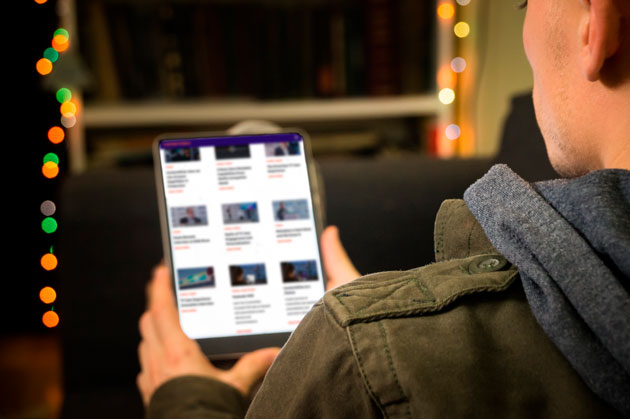
Articles
Client-side recommendations for broadcasters: a new approach
You are here:
Content personalization is currently offered by many two-way TV services (e.g., IPTV, OTT), where the return channel — i.e. the communication from the user’s set-top box (STB) to the service provider — allows a centralized system to identify and monitor the user’s actions in order to generate personalized recommendations.
Unfortunately, traditional TV systems (e.g. satellite TV) only allow one-way communication, preventing the use of a centralized recommendation engine. Thus, customers of broadcasting services (DVB-T and DVB-S) still mostly consume a traditional TV experience, where no personalization is provided and searching for appealing content to watch on TV is limited to either browsing the EPG (Electronic Programming Guide) or zapping among hundreds of channels.
The use of recommender systems in broadcasting services would let service providers offer a set of new applications, such as, for example:
- Push VoD. The STB could preload a personalized subset of the on-demand content catalog, where movie selection is tailored to the subscriber’s preferences. The STB internal hard drive has a limited capability and the recommendation technology would allow to optimize the use of this limited resource by storing a selection of movies and programs that are likely to match the subscriber’s tastes and interests.
- EPG Recommendations. The STB could provide recommendations on the EGP on the basis of the user activity history, helping the user to rapidly sift through hundreds of channels and to find interesting TV programs.
- Targeted Advertising. The STB could preload a set of personalized ads and insert them in Linear TV as well as VoD. Delivering the right message to the right customer at the right time is a key factor for advertising effectiveness.
Can we provide personalized recommendations to customers of one-way broadcasting services?
We have recently introduced an approach designed to do just that at the recent Broadcast Engineering Conference (NAB 2012), just held in Las Vegas.
The main issue with broadcast networks is that they do not allow recommendations to be computed server-side, because it is not possible to collect users feedback, ratings and activity. Thus, recommendations must be computed client-side. It’s the user’s STB that is in charge of generating the personalized list of items (e.g. TV programs of VoD movies) to be suggested to the user.
Let’s see how personalized recommendations can be still processed by the STB under such conditions.
Content-based recommendations can be computed in a straightforward way. For example, let’s assume the service provider pushes EPG tags (e.g., genres, featured keywords) together with the TV program to stream. When the user watches a TV show, the STB tracks his activity and updates his preferences, by updating the list of tags related to the program the user just watched. The tags with the largest number of preferences will implicitly represent the user profile and will drive the recommendations of new content. The main challenge with content-based recommendations is the limited computational capability of low-power STBs, but modern STBs provide enough firepower to perform this task with sufficient accuracy.
Content-based systems are however second-best to community-based recommender systems, which are known to provide the most accurate recommendations. Community-based recommendations in broadcast networks represent the real challenge. In fact, such approaches generate recommendations based on patterns and correlations discovered in the users’ activities; roughly speaking, they suggest items that other users with similar tastes “liked” in the past, according to their viewing histories. Broadcast networks do not allow the service provider to collect user preferences in a central location, preventing the recommender system to analyze such preferences and finding out user behavior patterns.
To implement community-based approaches in broadcasting services, we have proposed at NAB to “learn” community patterns on an external, auxiliary domain, where the presence of a feedback channel allows to centrally collect users’ preferences. A mathematical model of the discovered patterns can then be transferred from the auxiliary domain to our target domain – i.e. the broadcast target user population, and eventually broadcast to the STBs through the one-way communication network. STBs can finally generate recommendations locally using the computational model transferred from the auxiliary domain and applying it to the user activity history tracked locally.
The time is ripe for content personalization to customers of broadcasting services too!
Related News
Articles
Like VOD but in four dimensions? FAST channel programming automation and personalization with Contentwise Playlist Creator
Thanks to automation and AI, Playlist Creator, leverages content recommendation recipes to generate FAST channel playlists that are fed to cloud playout systems.
